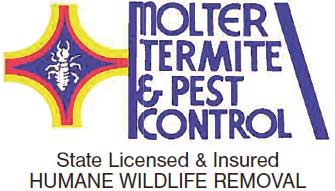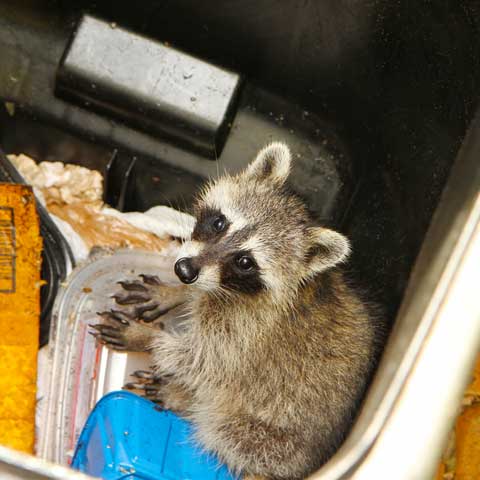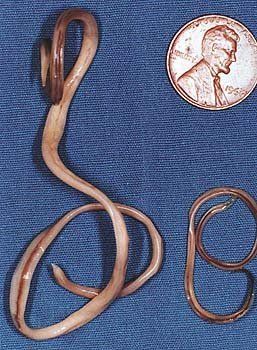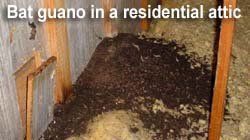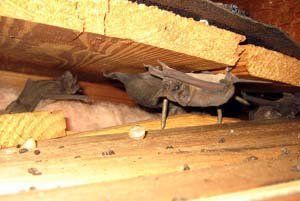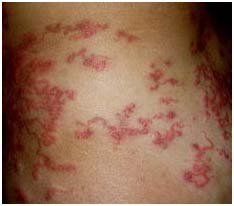Florida odor control, and dead animal removal
The most common cleanup and decontamination we do is for rodent droppings in the attic over the garage. Most people use their attics for storage. Rats leave a mess all over your belongings and holiday items commonly stored in attics. Molter can clean up the feces and decontaminate your storage areas to make it a safe for you and your family again. Cleanups are also commonly performed before customers put their home up for sale as animal dropping will surely scare off potential buyers when their home inspector makes them aware of the problem. For large rat infestations, as well as raccoon and opossum feces, attic retorations may be needed.
Depending on the severity of the raccoon droppings and urine areas, your home owners insurance may cover it. Molter’s wildlife professionals will decide this on a case by case basis and work with you step by step. The majority of the time, partial attic restorations and a bacterial digester treatment are what’s needed to make the area safe again. Make sure to look below some of the health risks which may come from each animal. Call Molter for your free estimate and inspection. Molter will design a custom decontamination or odor control program to suit your needs exact needs if a problem exists.
Rats:
Hantavirus - a deadly disease that attacks the pulmonary system caused by a virus that becomes airborne when fecal matter is disturbed
Food Poisoning - contamination of foods by rodent urine or feces is a common cause of salmonella
Asthma - rodent urine and urine proteins has been shown to greatly complicate the symptoms of asthma and asthma related ailments and is the second leading cause of asthma
Lyphocytic Choriomeningitis Virus - transmitted through contact with rodent feces. The effects can vary from incidental symptoms to a form of meningitis
Bubonic Plague - spread by fleas feeding on rodent carries. It is an aggressive bacterial disease whose symptoms include chills, fever, diarrhea, headaches, and the swelling of the infected lymph nodes as the bacteria replicate there. If left untreated, the rate for the death is 50-90%
Rickettsial Pox - Transmitted via rodent-borne mites. It causes lesions followed by fever, headache, and rashes.
Rabies - Although extremely rare in rats, it is possible. Rabies is the most commonly feared and talked about health risk with any wildlife with our customers. Rabies is almost invariably fatal to humans if post-exposure prophylaxis is not administered prior to the onset of severe symptoms. The rabies virus infects the central nervous system ultimately causing disease in the brain and death
If you believe you have been exposed, or are experiencing symptoms, seek medical attention immediately!
Raccoons:
Raccoons are the primary host of Baylisascaris procyonis, a roundworm. Raccoons become infected with roundworm in one of two ways:
#1. Young raccoons become infected by eating eggs during foraging, feeding, and grooming.
#2. Adult raccoons acquire the infection by eating rodents, rabbits, and birds infected with the larvae of Baylisascaris. Roundworm eggs are passed in the feces of infected raccoons. Raccoons defecate in communal sites, called latrines. Raccoon latrines are often found at bases of trees, unsealed attics, or on flat surfaces such as logs, tree stumps, rocks, decks, and rooftops. Predator animals, including dogs, may become infected by eating an animal that has been infected with Baylisascaris. In some dogs, Baylisascaris may develop to adult worms and pass eggs in the dogs' feces.
The worms develop to maturity in the raccoon intestine, where they produce millions of eggs that are passed in the feces. Eggs that are excreted by raccoons are not immediately infectious. These eggs must develop in the environment for 2 to 4 weeks, after which the eggs are able to cause infection. The eggs are resistant to most environmental conditions and with adequate moisture, can survive for years. Young children are at risk for Baylisascaris infection as they may be more likely to put contaminated fingers, soil, or objects into their mouths. Humans become infected by ingesting embryonated (fertile) eggs.
Anyone who is exposed to environments where raccoons frequent is potentially at risk. Young children or developmentally disabled persons are at highest risk for infection as they may be more likely to put contaminated fingers, soil, or objects into their mouths. Hunters, trappers, taxidermists, and wildlife handlers may also be at increased risk if they have contact with raccoons or raccoon habitats. People become infected when they accidentally ingest infective eggs in soil, water, or on objects that have been contaminated with raccoon feces. When humans ingest these eggs, they hatch into larvae in the person's intestine and travel throughout the body, affecting the organs and muscles. Depending on where the larvae migrate, Baylisascaris infection can affect the brain and spinal cord (neural larva migrans), the eye (ocular larva migrans), and/or other organs (visceral larva migrans). Signs and symptoms depend on how many eggs are ingested and where in the body the larvae migrate (travel). Symptoms of infection may take a week or so to develop and may include nausea, tiredness, liver enlargement loss of coordination, lack of attention to people and surroundings, loss of muscle control, blindness, coma, and in severe cases even death.
No drugs have been shown to be totally effective for the treatment of Baylisascaris (roundworm) infection
If you believe you have been exposed, or are experiencing symptoms, seek medical attention immediately!
Squirrels:
Rabies - Rabies is the most commonly feared and talked about health risk with any wildlife. Rabies is almost invariably fatal to humans if post-exposure prophylaxis is not administered prior to the onset of severe symptoms. The rabies virus infects the central nervous system ultimately causing disease in the brain and death
Tick fever - Squirrels attract fleas and ticks and bring them into your attic with them and leave them in their nest. If a squirrel leaves the nest for an extended period of time, the fleas and ticks will look for new hosts. If tick fever sets in, you can expect flulike symptoms include fever and chills, severe headache, achy muscles (myalgia), stiff neck, light intolerance and, in some cases, a spotted rash.
Powassan encephalitis - Early signs of Powassan usually include headache, fever, nausea, vomiting, stiff neck, and sleepiness. In later stages, signs such as respiratory distress, tremors, confusion, seizures, coma, paralysis, and sometimes even death can occur.
If you believe you have been exposed, or are experiencing symptoms, seek medical attention immediately!
Bats:
Histoplasmosis - Bat guano carries the spores for Histoplasmosis, a fungal infection most often affecting the lungs of humans. The risk is much greater for those with immunity disorders, the elderly, the very young, and asthma. These people are at much higher risk for developing meningitis. Depending on the type contracted, symptoms include fever, chills, cough, chest pain, shortness of breath, neck stiffness, mouth sores, skin lesions, body aches, rashes, and skin nodules. Complications can cause scarring in the chest that can entrap major blood vessels, the esophagus, heart, and lymph nodes.
Rabies - Rabies is the most commonly feared and talked about health risk with any wildlife. If you suspect you have been bitten, get medical attention right away. If you are sleeping, and awake to find a bat on your skin (yes it happens) do not risk it. Have it looked at by a medical professional immediately as bites are not often felt. Rabies is almost invariably fatal to humans if post-exposure prophylaxis is not administered prior to the onset of severe symptoms. The rabies virus infects the central nervous system ultimately causing disease in the brain and death
Histoplasmosis - Bat guano carries the spores for Histoplasmosis, a disease mainly affecting the lungs of humans. The risk is much greater for those with immunity disorders, the elderly, and the very young.
Mites - Bats also carry bat mites. They are often mistaken for bed bugs. Many other exterminators mistake these for bed bugs and will treat a building as such as such only to be called back over and over again as the presence of bats will allow new ones to take their place.
If you believe you have been exposed, or are experiencing symptoms, seek medical attention immediately!
Opossums:
The most common problems with opossums is fleas, ticks, mice and lice which they can transmit to humans, or to cats and dogs. Many customers think the opossum is a harmless creature and more an annoyance than anything. It is quite the contrary. If they are left near your property, they can infect the soil with all types of health risks. If an opossum is allowed to nest in the crawl space or attic of your house, mobile home, or a business, the opossum’s fleas, ticks, mites and/or larva migrans can find their way into your home.
Cutaneous Larva Migrans As you can see by the picture at left, if the larva from an opossum is left untreated, the health risks are not pretty.
Tuberculosis - Tuberculosis is a common and in many cases lethal infectious disease caused by various strains of mycobacteria. It normally attacks the lungs. The classic symptoms are chronic cough, fever, night sweats, and weight loss.
Rabies
- Rabies is the most commonly feared and talked about health risk with any wildlife. If you suspect you have been bitten, get medical attention right away. Rabies is almost invariably fatal to humans if post-exposure prophylaxis is not administered prior to the onset of severe symptoms. The rabies virus infects the central nervous system ultimately causing disease in the brain and death
Tularemia - Most people exposed to tularemia who become sick generally do so within two to ten days. Symptoms generally include a skin ulcer at the site of infection, swollen and painful lymph glands, fever, chills, headache, sore throat, vomiting, diarrhea, chest pain, difficulty breathing, and exhaustion.
Spotted Fever - A disease brought on by a bacterial infection spread to humans through a tick bite. Symptoms may include chills, confusion, fever, headache, muscle pain, a rash that spreads to most of the body, diarrhea, light sensitivity, hallucinations, loss of appetite, nausea, extreme thirst, and vomiting
Toxoplasmosis - It an infection due to a parasite that is transferred from animal droppings by accidental consumption of infectious particles. Symptoms include enlarged lymph nodes, headache, fever, muscle pain, sore throat, confusion, retinal inflammation that causes blurred vision, and seizures.
Coccidiosis - Is a parasite that infects the intestinal tracts of animals. Contact for humans normally occurs from the shedding of the parasite from infected feces onto food or in water and ingested. Symptoms include watery diarrhea, weight loss, fever, abdominal pain, nausea and vomiting.
Chagas Disease - Is a parasite transferred by reduvid bugs carried by many animals. Symptoms include fever, flu like symptoms, swelling of one eye, swollen red area at the site of the insect bite, constipation, digestive problems, abdomen pain and swallowing difficulties
If you believe you have been exposed, or are experiencing symptoms, seek medical attention immediately!
Armadillo:
Leprosy - Leprosy has two common forms, tuberculoid and lepromatous. Both forms produce sores on the skin. However, the lepromatous form is most severe. It causes large lumps and bumps. Lesions have decreased sensation to touch, heat, or pain. Muscle weakness, numbness or lack of feeling in the hands, arms, feet, and legs. Studies have shown that as many as 20 percent of armadillos are infected with leprosy.
If you believe you have been exposed, or are experiencing symptoms, seek medical attention immediately!
HEPA FACTS:
